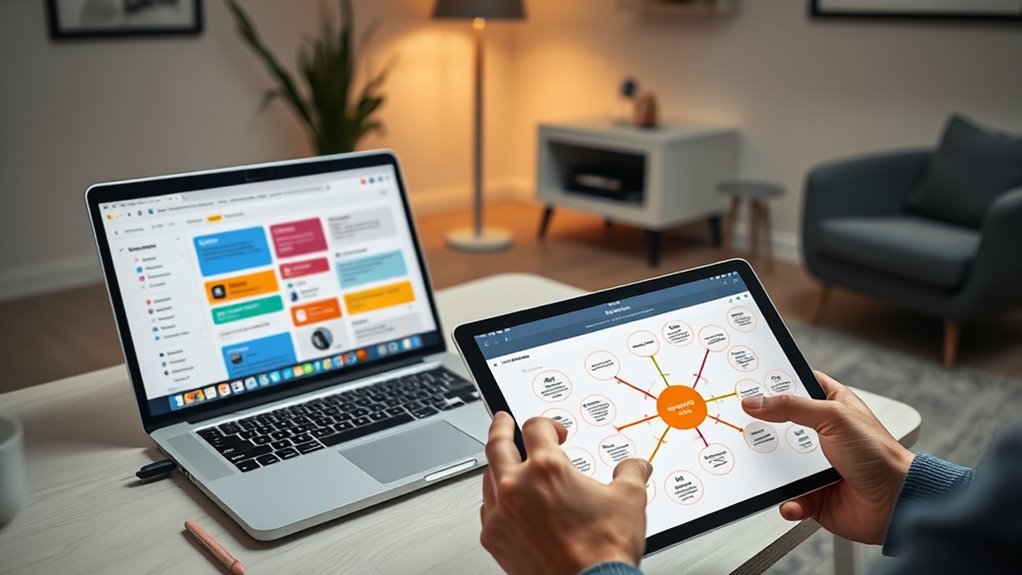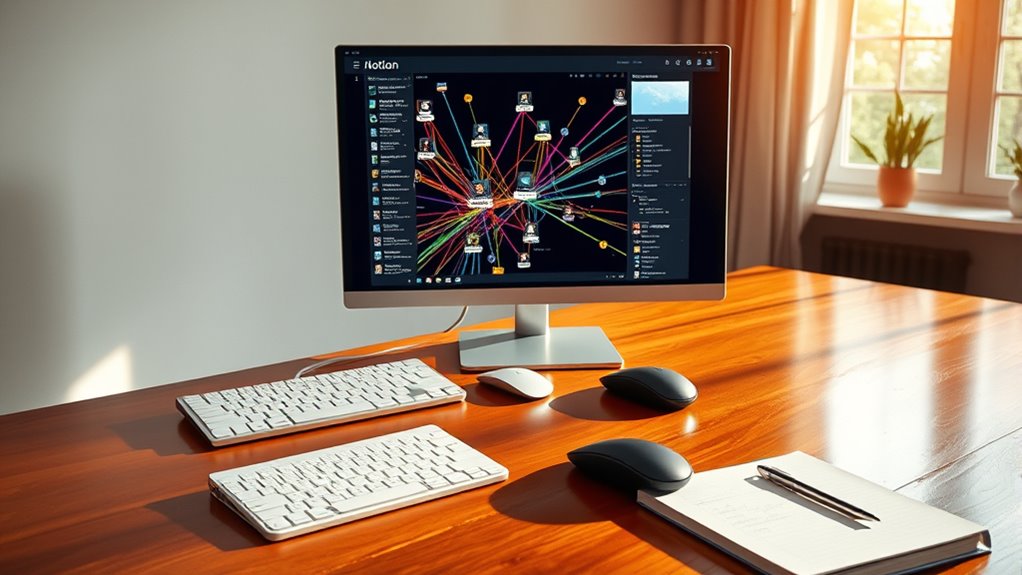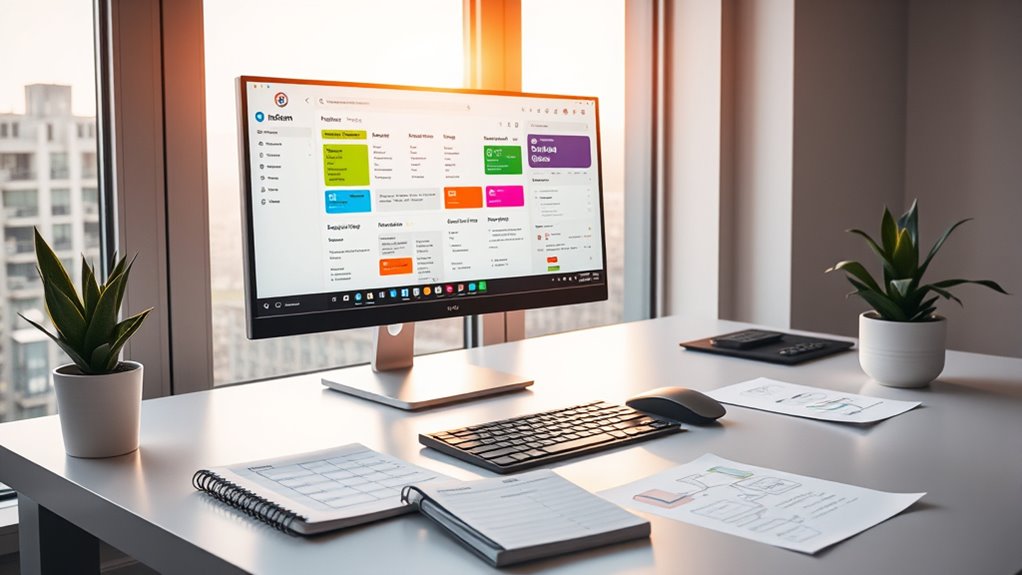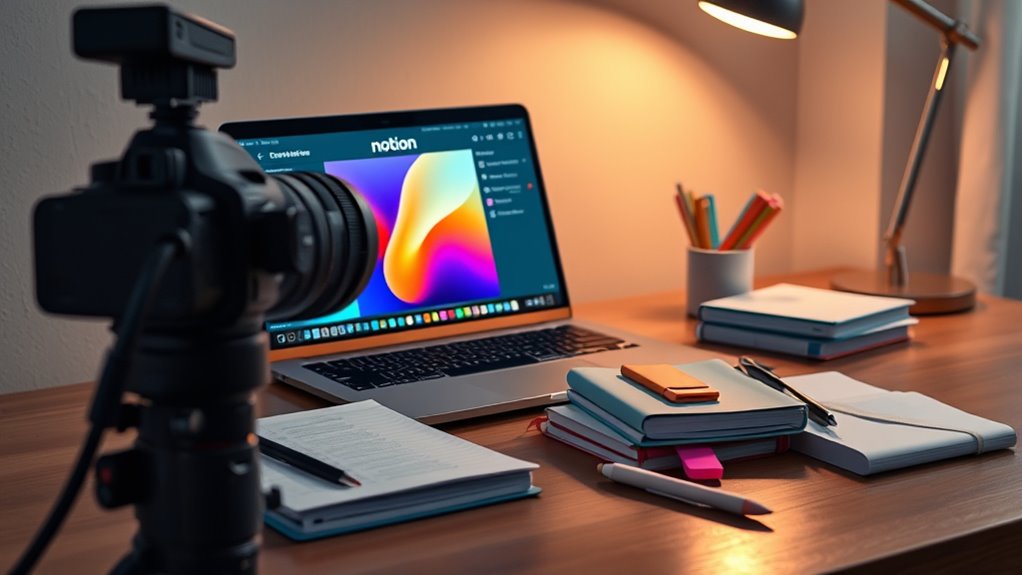To build a second brain in Notion step by step, start by designing a simple, clear structure that aligns with your goals. Create core databases for notes, projects, and resources, and establish tagging and naming conventions for easy retrieval. Link related data and use backlinks to connect ideas seamlessly. Regularly review and update your system to keep it relevant. If you continue exploring, you’ll discover how to fine-tune your setup for maximum productivity.
Key Takeaways
- Define your goals and create a clear hierarchy with folders and databases aligned to your workflows.
- Customize icons, tags, and naming conventions for easy navigation and quick retrieval.
- Establish relationships and backlinks between databases to interconnect related notes and ideas.
- Regularly review, update, and declutter your system to ensure relevance and efficiency.
- Maintain consistent organization habits and experiment with structure to optimize your second brain.
Understanding the Concept of a Second Brain and Its Benefits

A second brain is a digital system designed to store, organize, and retrieve your knowledge and ideas efficiently. It acts as an extended digital memory, helping you remember important details and insights without relying solely on your brain’s capacity. By offloading information into this system, you free up mental space, which enhances your cognitive function and focus. This setup allows for faster access to ideas and connections, boosting your productivity and creativity. A second brain isn’t just about saving information; it’s about transforming how you think and learn. With a reliable digital memory, you gain better cognitive enhancement, making it easier to handle complex projects, develop new skills, and stay organized. Understanding the role of contrast ratio can further optimize how you evaluate and improve your system’s visual clarity and effectiveness. Ultimately, it empowers you to think more clearly and work smarter.
Setting Up Your Notion Workspace for Optimal Organization

To keep your Notion workspace efficient, you need to design a clear structure that suits your workflow. Use tagging and categorization to easily find and connect related ideas. Setting these foundations upfront will make your second brain more powerful and manageable. Incorporating best practices for content organization can further enhance your system’s effectiveness.
Workspace Structure Design
Designing your Notion workspace begins with creating a clear hierarchy that aligns with your goals and workflows. Start by establishing a folder hierarchy that logically organizes your projects, notes, and resources. Use folders to group related content, making navigation intuitive. Incorporate icon customization to visually distinguish different sections and enhance usability. Choose icons that reflect each category’s purpose, so you can quickly identify content at a glance. Keep your structure simple and consistent, avoiding unnecessary layers that could complicate access. A well-designed workspace minimizes clutter and streamlines your daily routines. Remember, the goal is to create an environment that supports efficient workflows and easy retrieval of information, helping you build a second brain that works seamlessly for your needs. Incorporating interior design basics ensures your workspace is both functional and inspiring, fostering creativity and productivity.
Tagging and Categorization
Implementing effective tagging and categorization in your Notion workspace helps you find and organize information quickly. Using consistent tags organization and clear categorization strategies makes your second brain more accessible. Assign relevant tags to notes, projects, and resources to streamline retrieval. For example, use tags like “research,” “meeting,” or “idea” to label content intuitively. To illustrate, consider this categorization approach:
| Tag Type | Purpose | Example Tags |
|---|---|---|
| Status | Track progress | “In Progress,” “Done” |
| Priority | Highlight importance | “High,” “Low” |
| Context | Specify working environment | “Offline,” “Online” |
| Theme | Group similar topics | “Marketing,” “Finance” |
| Deadline | Manage timelines | “Next Week,” “Urgent” |
These strategies optimize your workspace for quick access and better organization. Additionally, understanding content organization principles helps you structure your second brain more effectively for long-term clarity and productivity.
Creating Core Databases for Notes, Projects, and Resources

To create effective core databases, you need a clear structure that supports easy access and updates. Setting consistent naming conventions helps keep everything organized, while linking and tagging enable seamless connections across your data. Focus on these points to build a solid foundation for managing notes, projects, and resources efficiently.
Database Structure Design
Creating a solid core for your second brain starts with establishing well-structured databases for notes, projects, and resources. A clear metadata schema helps you categorize and filter information efficiently, making retrieval seamless. Focus on data normalization to reduce redundancy, ensuring each piece of information is stored only once and linked appropriately. Design your databases to include essential fields like tags, dates, and statuses, which support flexible organization. Avoid clutter by limiting unnecessary columns, and keep relationships between tables straightforward. Well-designed structures allow your second brain to grow organically without becoming unwieldy. By paying attention to metadata schemas and normalization, you set a strong foundation for future automation, easy updates, and intuitive navigation. Incorporating water-related concepts can also inspire a fluid and adaptable structure that accommodates growth over time.
Naming Conventions Setup
Establishing consistent naming conventions for your core databases—notes, projects, and resources—sets the foundation for easy organization and quick retrieval. Use descriptive labels that clearly identify each database’s purpose, such as “Meeting Notes,” “Client Projects,” or “Research Resources.” Keep naming patterns uniform to avoid confusion; for example, always start with a category or date. This consistency helps you find information faster and ensures your workspace remains tidy. Avoid vague titles like “Stuff” or “Misc.” Instead, be specific to your workflow. By establishing these conventions early, you create a clear structure that scales as your second brain grows. Remember, the goal is simplicity and clarity, making your databases intuitive and easy to navigate. Incorporating organized visual cues can further enhance quick recognition and access within your Notion setup.
Linking and Tagging
Linking and tagging are essential practices that transform your Notion workspace into a connected, easily navigable network. They enable quick access and effective organization of your notes, projects, and resources. By implementing hierarchical tagging, you create a layered classification system that reflects your thought process, making retrieval more intuitive. Backlinking strategies connect related notes, fostering a web of ideas that enhances understanding. To optimize this system, consider:
- Establishing core databases for notes, projects, and resources.
- Using hierarchical tags to categorize content at multiple levels.
- Applying backlinking to connect relevant entries, creating a dense network of relationships.
- Incorporating organized storage solutions to maximize space and maintain order within your digital workspace.
These methods streamline your Second Brain, ensuring information flows seamlessly and stays interconnected.
Establishing a System for Capturing and Tagging Ideas

To effectively manage your ideas, you need a reliable system for capturing and tagging them as soon as they come to mind. Start by creating a simple capture method, like a quick note in Notion or a mobile app, to avoid losing ideas. When tagging, focus on idea categorization by developing a clear tag hierarchy that reflects different themes or projects. Use broad tags for general categories and specific tags for details, ensuring quick retrieval later. Consistency is key; stick to your system so you can easily find related ideas later. This approach streamlines your workflow, keeps your thoughts organized, and makes future linking and interconnection smoother. A well-structured capturing and tagging system forms the foundation of your second brain. Additionally, understanding the subtopics related to your content can help you organize your ideas more effectively and ensure comprehensive coverage of your themes.
Linking and Interconnecting Your Databases for Seamless Navigation

Connecting your databases in Notion transforms your second brain into a dynamic, interconnected system. This setup enhances navigation, making information retrieval effortless. To do this effectively, focus on establishing strong database relationships using linked databases and relation properties. Implement cross referencing techniques to connect related pages and data points seamlessly. Here are three key steps:
- Create relation properties between relevant databases to establish clear links.
- Use rollups to display related data, providing context at a glance.
- Regularly review and update links to keep your network of information current, which is especially important for managing complex data like divorce statistics or legal resources.
Maintaining and Evolving Your Second Brain for Continuous Growth

Maintaining and evolving your second brain is an ongoing process that guarantees it remains a valuable and effective tool for your growth. Regular habit tracking helps you stay consistent with your organization routines, ensuring your system adapts to your changing needs. Incorporate content review sessions to refine your database, discard outdated information, and highlight new insights. These practices keep your second brain relevant and aligned with your goals. As you progress, experiment with new workflows or reorganize sections to improve usability. Continuously engaging with your setup prevents stagnation, encouraging continuous improvement. By actively managing and updating your second brain, you create a dynamic system that supports your learning, productivity, and personal development over time. Additionally, understanding the principles of Gold IRA can inspire you to diversify your knowledge management strategies, much like diversifying an investment portfolio to safeguard against market volatility.
Frequently Asked Questions
How Often Should I Review and Update My Second Brain?
You should review your second brain regularly to keep it useful and organized. A good rule of thumb is to do a quick review weekly, updating routines as needed. This helps you stay on top of new information and guarantees your system remains relevant. Adjust your review frequency if you notice things piling up or if your needs change, but consistency is key to making your second brain work effectively.
What Are Common Mistakes to Avoid When Building My System?
When building your system, avoid mislabeling categories, which can cause confusion and slow retrieval. Also, neglecting regular cleanup leads to clutter and outdated info. You should consistently review and refine your setup, ensuring categories stay relevant and organized. By staying proactive, you keep your second brain efficient and useful, preventing it from becoming overwhelming or disorganized over time. Regular maintenance is key to a successful system.
Can I Integrate Notion With Other Productivity Tools?
You can definitely explore integration options with Notion to enhance your productivity. Notion offers various ways to connect with other tools, like using third-party apps, APIs, or automation platforms such as Zapier and Make. Check tool compatibility first to guarantee smooth integration. This way, you can streamline workflows, automate tasks, and keep all your information synchronized, making your second brain more efficient and accessible across different platforms.
How Do I Ensure My Second Brain Stays Clutter-Free?
To keep your second brain clutter-free, focus on solid organization habits like regularly reviewing and sorting your notes. Use decluttering techniques such as archiving outdated items and consolidating related information. Make it a routine to delete unnecessary files and categorize content clearly. By consistently practicing these habits, you’ll maintain a streamlined, efficient system that helps you find what you need quickly and keeps your second brain tidy.
What Are Best Practices for Backing up My Data?
To back up your data effectively, you should prioritize data encryption to keep your information secure and use storage redundancy to prevent data loss. Regularly export your notes and store copies in multiple locations, like cloud services and external drives. Automate backups when possible, and verify your backups periodically to guarantee they work. This way, your second brain remains safe, accessible, and clutter-free, even if technical issues arise.
Conclusion
Building a second brain in Notion transforms how you organize and access your ideas, boosting productivity and creativity. Did you know that people who use digital note systems are 30% more likely to remember information and generate new ideas? By setting up your workspace thoughtfully and maintaining it, you’ll unleash your full potential. Keep evolving your system, and watch your knowledge grow exponentially—making every moment of effort truly worthwhile.









